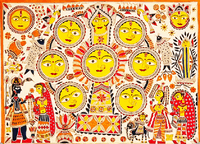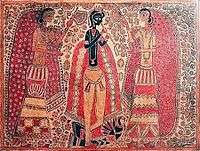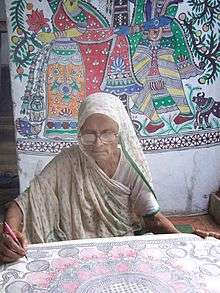Madhubani/Mithila Painting

Madhubani art (or Mithila painting) is practiced in the Mithila region of India and Nepal. Painting is done with fingers, twigs, brushes, nib-pens, and matchsticks, using natural dyes and pigments, and is characterised by eye-catching geometrical patterns. There is ritual content for particular occasions, such as birth or marriage, and festivals, such as Holi, Surya Shasti, Kali Puja, Upanayana, Durga Puja.
Origins
Madhubani art or Mithila painting was traditionally created by the women of various communities in Mithila region of India and Nepal. It originated from Madhubani district of Mithila region of Bihar, and, it is popularly called Mithila painting or Madhubani art. Madhubani is also a major export centre of these paintings.[1] This painting as a form of wall art was practiced widely throughout the region; the more recent development of painting on paper and canvas mainly originated among the villages around Madhubani, and it is these latter developments led to the name Madhubani art being used alongside the name "Mithila Painting."[2]
The painting was traditionally done on freshly plastered mud walls and floors of huts, but now they are also done on cloth, handmade paper and canvas.[3] Madhubani paintings are made from the paste of powdered rice. Madhubani painting has remained confined to a compact geographical area and the skills have been passed on through centuries, the content and the style have largely remained the same. And that is the reason for Madhubani painting being accorded the coveted GI (Geographical Indication) status. Madhubani paintings also use two dimensional imagery, and the colors used are derived from plants. Ochre and lampblack are also used for reddish brown and black respectively.
Madhubani paintings mostly depict the men & its association with nature and the scenes & deity from the ancient epics. Natural objects like the sun, the moon, and religious plants like tulsi are also widely painted, along with scenes from the royal court and social events like weddings. Generally no space is left empty; the gaps are filled by paintings of flowers, animals, birds, and even geometric designs. Traditionally, painting was one of the skills that was passed down from generation to generation in the families of the Mithila Region, mainly by women.[4] It is still practiced and kept alive in the institutions spread across Mithila region. Kalakriti[5] in Darbhanga,[6] Vaidehi in Madhubani, Benipatti in Madhubani district and Gram Vikas Parishad in Ranti are some of the major centers of Madhubani painting which has kept this ancient art form alive.

Styles
Madhubani art has five distinctive styles, namely, Bharni, Katchni, Tantrik, godna and kohbar. In the 1960s Bharni, Kachni and Tantrik style were mainly done by Brahman and Kayashth women, who are 'upper caste' women in India and Nepal. Their themes were mainly religious and they depicted Gods and Goddesses, flora and fauna in their paintings. People of lower castes include aspects of their daily life and symbols, story of Raja Shailesh [ guard of village] and much more, in their paintings. But nowadays Madhubani art has become a globalised art form so there is no difference in the work of artists of the region on the basis of caste system . They are working in all five styles. Madhubani art has received worldwide attention.[7]
Artists and awards
Madhubani painting received official recognition in 1969 when Sita Devi received the State award by Government of Bihar. In 1975, President of India gave the Padma Shri award to Jagdamba Devi, and the National Award to Sita Devi of Jitwarpur village near Madhubani.[8] Sita Devi received the Padma Shri in 1981. Sita Devi was also awarded by Bihar Ratna in 1984 and Shilp Guru in 2006. In 1984 Ganga Devi [9] was awarded by Padma Shri.[10] Mahasundari Devi received the Padma Shri in 2011. Bauwa Devi, Yamuna Devi, Shanti Devi, Chano Devi, Bindeshwari Devi, Chandrakala Devi, Shashi kala Devi, Leela Devi, Godavari Dutta, and Bharti Dayal were also given the National award.[11][12][13] Chandrabhushan, Ambika Devi, Manisha jha were also given the National award.
Gallery
 First Night: Bride & Groom
First Night: Bride & Groom God Vishnu in Fish Avtaar
God Vishnu in Fish Avtaar Madhubani Painting Exhibition at CBD Belapur Navi Mumbai
Madhubani Painting Exhibition at CBD Belapur Navi Mumbai A traditional Madhubani artist at work
A traditional Madhubani artist at work.jpg) A modern expression of Madhubani
A modern expression of Madhubani
References
- ↑ "Madhubani Painting". Abhinav Publications. 30 September 2017. Archived from the original on 21 February 2017 – via Google Books.
- ↑ Carolyn Brown Heinz, 2006, "Documenting the Image in Mithila Art," Visual Anthropology Review, Vol. 22, Issue 2, pp. 5-33
- ↑ Krupa, Lakshmi (4 January 2013). "Madhubani walls". The Hindu. Archived from the original on 29 January 2014. Retrieved 5 February 2014.
- ↑ "Know India: Madhubani Painting". India.gov.in. Archived from the original on 7 September 2011. Retrieved 21 September 2013.
- ↑ https://encrypted.google.com/maps/place/Kalakriti,+mithila+painting+store/@26.16902,85.895148,15z/data=!4m2!3m1!1s0x0:0x22e7e9059046e00e?hl=en&sa=X&ved=0ahUKEwji4L-ii7TaAhXIqY8KHeLcDIQQ_BIIgQEwDw
- ↑ "Kalakriti Mithila painting - Wikimapia". wikimapia.org. Archived from the original on 10 May 2017.
- ↑ {{cite web|url=https://www.atulyabihar.com/a-painter-from-patna-crafted-a-live-madhubani-painting-in-bangkok/ |title=a-painter-from-patna-crafted-a-live-madhubani-painting-in-bangkok
- ↑ "Padma Shri" (PDF). Padma Shri. 2015. Archived from the original (PDF) on 15 November 2014. Retrieved 11 November 2014.
- ↑ Jyotindra Jain (1989). "Ganga Devi: Tradition and expression in Madhubani painting". Taylor and Francis Online. 3 (6). doi:10.1080/09528828908576213.
- ↑ "Padma Awards" (PDF). Ministry of Home Affairs, Government of India. 2015. Archived from the original (PDF) on 15 November 2014. Retrieved 21 July 2015.
- ↑ Madhubani painting – Upendra Thakur – Google Boeken. Books.google.com. Retrieved 2013-09-21.
- ↑ Tripathi, Shailaja (22 November 2013). "Madhubani beyond the living rooms". The HIndu. Archived from the original on 31 January 2014. Retrieved 3 February 2014.
- ↑ "Art that subverts". 26 August 2013. Archived from the original on 26 August 2013 – via www.thehindu.com.
Further reading
- Kossak, Steven (1997). Indian court painting, 16th-19th century.. New York: The Metropolitan Museum of Art. ISBN 0-87099-783-1. (see index: p. 148-152)
External links
| Wikimedia Commons has media related to Madhubani painting. |
- Madhubani - age old rural art from in Bihar
- Collection of Madhubani Paintings of Various Top artists
- In conversation with Indian Express, the Madhubani Artist Vidushini shares her views on preserving traditional art forms including Mithila Paintings.
- Official Website of artist Bharti Dayal
- Indian Ministry of Culture featuring Gauri Mishra
- The official website of Gauri Mishra 'Maaji of Madhubani'
- Mithila Paintings
- official website of artist Manisha jha and madhubani art centre
- Mithila Painting, Benipatti, Madhubani * mithilapaintings.org